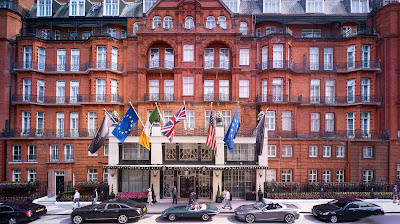 |
| La Savoie 82 - Chambésy - Rue de Boigne - Fontaine des Eléphants, oeuvre de Sappey (Fontaine des quatre Sans-Cul) |
As mentioned briefly in my previous post, between July 1922 and March 1924, there was an interlude in my great-aunt Gerda's employment with the Swedish Countess Sparre-Bielke at Sturefors castle, during which she was instead off travelling to 'exotic countries' with a Lady Henry - who at the end of that period declared Gerda to be an "excellent traveller and packer and a neat needlewoman".
Unfortunately, this is a period of Gerda's travels that I know very little about. I have no written postcards from those years; and neither do I have any blank cards from countries more 'exotic' than France. I seem to vaguely remember having heard (back in my childhood/youth) that Gerda had also been as far away as India, though. And my relative BW mentioned in an email a couple of small pistols that she was supposed to have carried in her handbag when travelling to the "colonies". So when I first saw this postcard with the elephants in her collection (of unwritten ones), I thought that might be from India. Of course the printed text in French immediately took me out of that illusion; but in lack of the "the real thing" (actual proof), I decided to use it for this post anyway.
A website (www.lonelyplant.com) confirms my impression of at least a connection to India:
With its four carved elephants, this 17.6m-high fountain looks like the model for an old Indian postage stamp. It was sculpted in 1838 in honour of Général de Boigne (1751–1830), who made his fortune in the East Indies and was honoured posthumously with this monument for bestowing some of his wealth on the town. Locally, the elephants – whose front halves sprout from the statue – are lovingly referred to as the quatre sans cul (the rear-less four).
The text continues:
The genteel arcaded street that leads from the fountain to Château des Ducs de Savoie, rue de Boigne, is also one of Boigne's projects.
There is a postcard of this as well, in Gerda's collection:
 |
| 28 CHAMBÉRY - Le Château des Ducs de Savoie, Le Donjon et la Porte Saint-Dominique - LL |
Savoie (English: Savoy) is a department in the Auvergne-Rhônes-Alpes region of Southeastern France. As I know Gerda spent some time in the French alps when she lived in France during WW1, she may have visited Chambéry back then as well. But it may also have been before, or after the war.
I've spent quite a bit of time googling for a travelling 'Lady Henry', but without finding anyone who seems to fit with this window in time (1922-24). I've also tried 'Lord' Henrys, and 'Sir' Henrys - the whole thing not getting any easier by the fact that Henry might be either a surname or a first name.
For a short while, I actually thought I might have a really exciting lead, when I did find an English earl by first name Henry, who had served in India and Mesopotamia during the war, and in July 1922 married an American girl; and after their marriage they did go to India... But as this couple is famous enough to even have a book written about them, it also soon became clear that no, alas - as much as I'd like to, I can't fit Gerda into their story... ;) Besides the fact that the couple went back to England in 1923, to take possession of an inherited estate, I actually even found out the name of the wife's maid, who was with them in India: She was called Marcelle, and had been with her "lady" since she was fourteen years old.
That couple's story is a very interesting one in its own right, though, and I look forward to continue reading the rest of it. The title of the book is Lady Catherine and the Real Downton Abbey, written by the current Countess of Carnarvon. It describes the lives of the family who lived at Highclere Castle from 1923 to 1945, "in particular the beautiful Anglo-American Catherine Wendell and the man she married, who became the 6th Earl of Carnarvon". (Better known as Lord Porchester, or Porchey, rather than Henry - even if that was his name.)
While I'll probably never find Gerda's Lady Henry, at least the first few chapters of this book gave me some thoughts about likely circumstances: In the context of travelling to 'exotic' countries, like India, it is perhaps more realistic to think of Lady Henry as being married to a gentleman with military or diplomatic background, rather than as a single gentlewoman setting off on a journey "on her own" to explore remote corners of the world in the company of just a lady's maid (however excellent at packing and needlework). (Or one might imagine Lord Henry already being in India, with his regiment; and his wife travelling to join him there. Or something along that line...)
Linking to Sepia Saturday 614

































